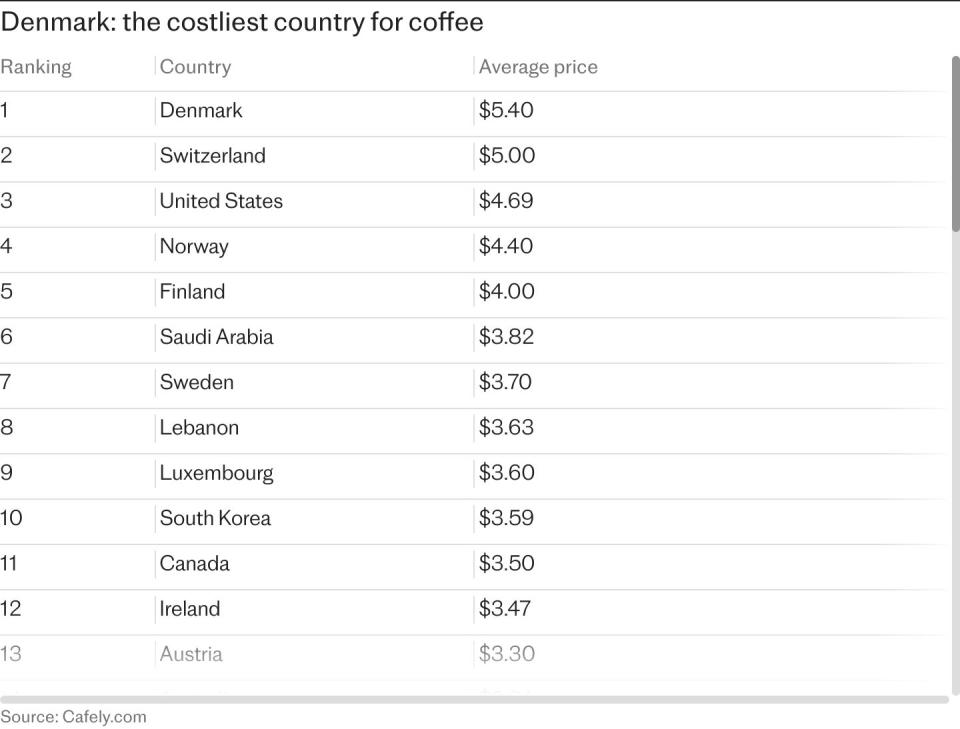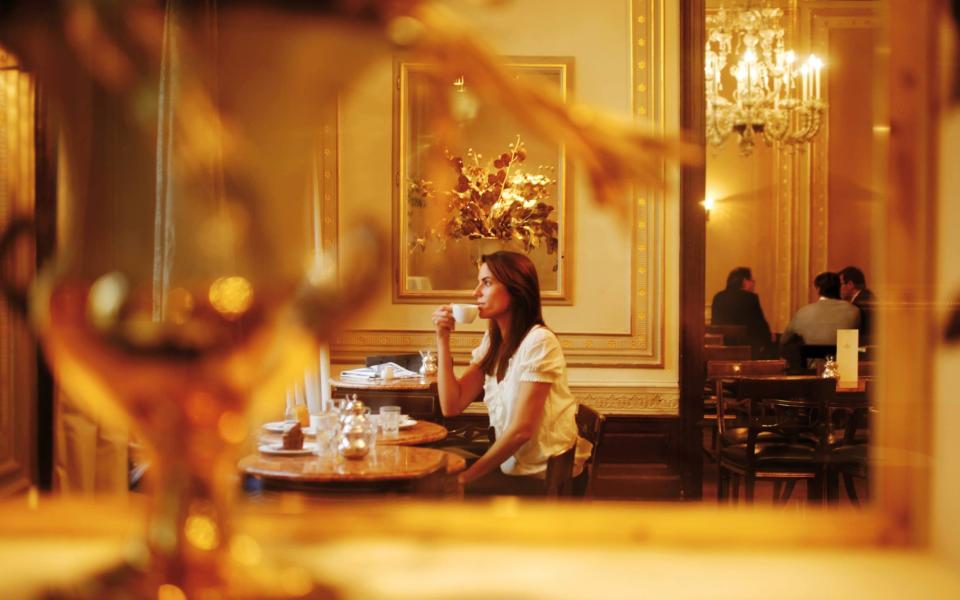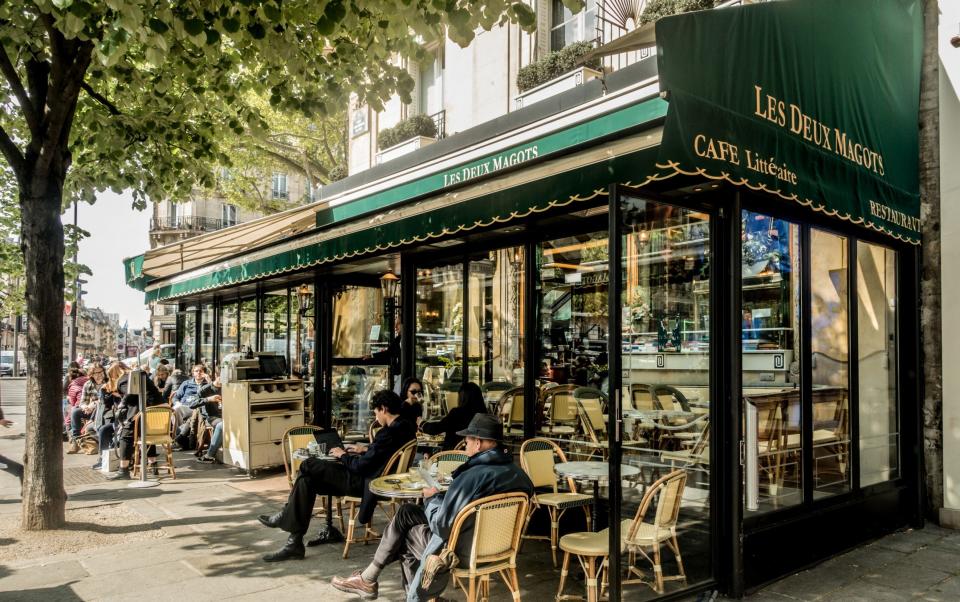While chatting with a bus driver in the center of Seville, he said he found a small coffee shop and had a nice espresso – “and it was cheap too, just one euro.” I am impressed. First of all, I had a hard time finding a place where I could get a black coffee; bars and restaurants in the tourist central area were more focused on flogging sangria. And another, I was still mourning my last coffee break in London: £4.05 for a terrible flat white at Gatwick’s Pret. No wonder the company doesn’t publish prices on its online “menu”.
I was in Seville for nine days traveling through Extremadura and Andalusia. I generally had good coffee and the numbers on my receipts looked reasonable: €2.50, €2.40, €1.70. Spain isn’t a famous coffee country, but that means it doesn’t over-hype the product, infantilize customers with dozens of attention-grabbing variations, or make a song and dance about what’s essentially a very simple drink.
A cup of filter coffee costs 88p in the Algarve, according to the Post Office’s latest holiday spending report. In contrast, the price of takeaway coffee in London exceeded £5; at least, at a chain called, appropriately enough, Black Sheep. The industry says it has been hit by rising energy and labor costs, while extreme weather (almost certainly due to climate change) has caused the wholesale price of coffee beans to rise by a fifth since last year.

At Starbucks, which also hides prices on its website, the £5 threshold has been surpassed by more baroque fake coffees. The caramel macchiato costs £5.15, while the white chocolate mocha costs £5.40. The most expensive coffee on the chain’s menu is the caramelised macadamia oat latte at £6.10.
Since 1990, coffee growers have increased production from 100 million to 175 million 60 kg bags. World coffee consumption is increasing by 2.0-2.5 percent every year. Over the past two decades, there has been a global boom in what are known as Third Wave coffee shops, places that take sourcing and roasting seriously and take the time to train their waiters or baristas.
Given that we’re all addicted to these things, where can we go to get the best (and best value) cafe experiences?
Orient espresso: Paris, Vienna and Venice
The price of a cup of coffee often reflects location. The most expensive coffee sold in Europe is famous in San Marco Square in Venice. In 2018, an angry tourist posted on Facebook that in the sunniest corner of the famous square, St. Mark’s Basilica. Each small coffee earned him €11.50 (£9.87).


Famous locales with exclusive addresses are not indicative of national averages. A recent study by coffee producer Cafely found that Denmark has the world’s most expensive average cup of coffee at £4.30. The report states that Switzerland, Norway, Finland and Sweden have similar prices, reflecting higher costs of living and specialty coffee preferences. Italy came 59th on the list (out of 65) with a typical price of £1.22.


For serious coffee lovers, quality is just as important as price. While Italy often comes out on top in this regard, France, which has traded on its “café society” image for more than a century, is widely regarded as a reliable supplier of espresso coffee and a place where urban culture – particularly in Paris – is deeply felt . It’s attached to the corner cafe.
“Paris cafes have always been laboratories of political, artistic and literary ideas,” says Paris-based writer and guide Edith de Belleville.
“And these have been since the 18th century and the Enlightenment; In the Middle Ages, these were mostly taverns. The French Revolution and the storming of the Bastille in 1789 began in the cafés of the Palais Royal in Paris. Poets such as Verlaine and Apollinaire also wrote their poems in cafes.
“It is still an important part of people’s daily lives and for the French, going to the café is a ritual. It’s a very enjoyable place. You can go alone without feeling lonely. A place to meet for business, friends or a romantic date. You can discuss politics or talk football with people you don’t know at the bar.
“Balzac said that the cafe counter is the people’s parliament. For example, I have many friends that I met at the cafe. Even my 23-year-old and 18-year-old sons go to the cafe to meet their friends or study. So the café in France is a phenomenon that spans all generations. “It is a symbol of the French art of living.”
Austria (especially Vienna, where coffee houses are on the Unesco list), Belgium, Portugal, Denmark and Turkey have a certain respect for their coffee culture. Barista techniques have become more common in Northern Europe, and in Scandinavia and the Netherlands you’re likely to find expensive freshly ground and roasted beans from countries of less obvious origin, such as Papua New Guinea and El Salvador. Usually there will be a bearded, apron-clad hero who can lather, twirl, and draw while bringing out dozens of flat whites at once. Cafely’s research found that Luxembourgers drink the most coffee at five cups a day; this equates to a staggering £340,000 over a lifetime.


Consistency is probably highest in Italy. But all cultures have their pitfalls for the caffeine addict. The French’s passion for UHT milk means milk coffee drinkers are often disappointed (and expect raised eyebrows when you ask for a “latte”). German hole-in-the-wall places still sell coffee with warm milk. Basic bars in Greece and Turkey still serve coffee with more parts than coffee. The chains’ worldwide spread means you can get bucket-sized, tasteless, Horlicks-coloured dishwater – arguably the real “Americano” – wherever you travel.
I travel, but this map reminds me again of the trauma of the continent: the ubiquity of UHT milk, the corresponding lack of fresh milk and poor quality tea. I take Yorkshire/Lancashire tea bags with me, but I can’t find a way to carry English milk and Derbyshire water. https://t.co/QmIe5SJc9d
— Father Grant Naylor (@FatherNaylor) January 10, 2023
One einspanner in the works
Coffee has been available in European cities since the 16th century. The Jamaica Wine House, known as Jampot, opened in 1652 and is considered the first coffee house in London. A few years later he came to Paris. Since then, each city has developed its own culture in terms of beer making, names, serving habits, waiters and drinking traditions (posture, time of day). Getting things wrong is a sure sign that you are not well traveled.
Coffee commandments in Italy include adding only milk in the morning, never saying “espresso,” and sticking to the Holy Trinity of caffè, cappuccino, and caffé latte (which can be caffè macchiato or latte macchiato). However, some enthusiasts have published printed guides containing 18 variations of them, and Trieste, home to Illy and many fine cafés, offers visitors a survival guide listing 67 coffee varieties.
As sociologist Giulia Carabelli writes: “To order espresso, one must ask for nero; if anyone wants to drink black If it is in a glass instead of a cup, we need to specify the following: in B (bicchiere or glass). I learned that workers prefer to drink coffee from a glass because it warms their hands in winter. Another participant told me that these names were developed over time to serve customers faster. Of course, no one could tell me how these names actually came about, but all of the respondents were proud to explain how to order coffee because of how this simple action happened. different In Trieste.”
Modeled on the important Habsburg city of Trieste, Vienna’s classically flamboyant cafes offer melanges, einspänners, fiakers, biedermeiers, Mozarts and Mokkas. The city continues to provide patrons with a palate-clearing glass of water, and many cafes still stock newspapers (often distributed on sticks).
Austrian writer Stefan Zweig described the typical Viennese cafe as “a kind of democratic club, open to all for the price of a cheap cup of coffee, where every guest can sit, talk, write, play cards for hours with this little treat.” , receive mail and above all consume unlimited newspapers and magazines.


Vienna’s intellectualism and fin de siecle He wrote that the prominence was largely due to the character of the city’s coffeehouses. Is this still true?
“Absolutely,” says Christian-André Weinberger, a guide with the Secret Vienna tour company. “It’s about an attitude towards life. Preferences for Viennese Kaffeehaus is an extension of living rooms or workplaces; here they can read a book, write a bestseller, enjoy tempting cakes, pies and tarts while enjoying companionship or self-centered seclusion in peace and quiet.
“Some special creations are borrowed from local institutions. Fiaker He is a horse carriage driver, einspänner a Single horse carriage etc. Mozart coffee, named after the composer, consists of black coffee, chocolate, cream and sometimes a little apricot liqueur.
“The Viennese coffeehouse is where history comes alive with the smell of fresh coffee and delicious pastries on a marble-topped table, the rustle of newspapers, Thonet chairs, chandeliers and Historical interior design. “Viennese coffee is a place where centuries and ambiance are consumed, but only coffee is on the bill.”
This is a far cry from the chaos at Pret and paying a fiver for blends that are so far removed from espresso that we really shouldn’t use the word “café” when talking about the big chains.
Style and content
After all, there are two types of coffee drinkers. People are obsessed with resources and technology, with cream and character. They prefer the barista-style coffee shop, like to vary their coffee beans and preparation techniques, and are likely to drink at their desk or on the go. The other type is more concerned with the cafe, the ambiance, the mood and the location. This is not just a matter of antiquity or beauty; many large cafes are tourist traps.
Edith de Belleville says: “For the French, the aesthetics of the place and the atmosphere are as important as the quality of the drink. This is what we call good taste. You can’t have one without the other.
“The only time I drank bad coffee in Paris was because the place was as ugly as the coffee was bad.”
He says that Parisians stay away from places frequented by tourists: “There is one cafe in Paris that we left to tourists, and that is Le Procope, one of the oldest cafes in the world, dating back to 1682. This place looks more like a restaurant than a cafe. You’ll never see a Parisian there.
“Elsewhere, tourists mix with regulars; Although it is true that I left the iconic Café de Flore and Les Deux Magots in Saint Germain-des-Prés with a heavy heart – not because there were tourists, but because there were so many of them and you spent so much time there. create a queue. “I refuse to queue for coffee.”


Me too. So I decided to boycott any place that made me wait in line, harassed me, had unhappy staff who spent days yelling, had tables or stools that probably seated a dozen people, but served hundreds of people at all hours.
I want a very nice place and a very good cup of coffee for a fiver. This is the Holy Grail and frankly I have yet to find a truly great, grand old cafe that can produce gorgeous, aromatic, warm but not too hot contemporary style coffee with some rich milk. My favorite coffee culture in Europe is probably in Spain, because it reminds me of Buenos Aires, where I discovered my caffeinated soul – but the quality of coffee in South America is very patchy indeed. I would really like to know where the perfect cafe can be found. Please answer the napkin.